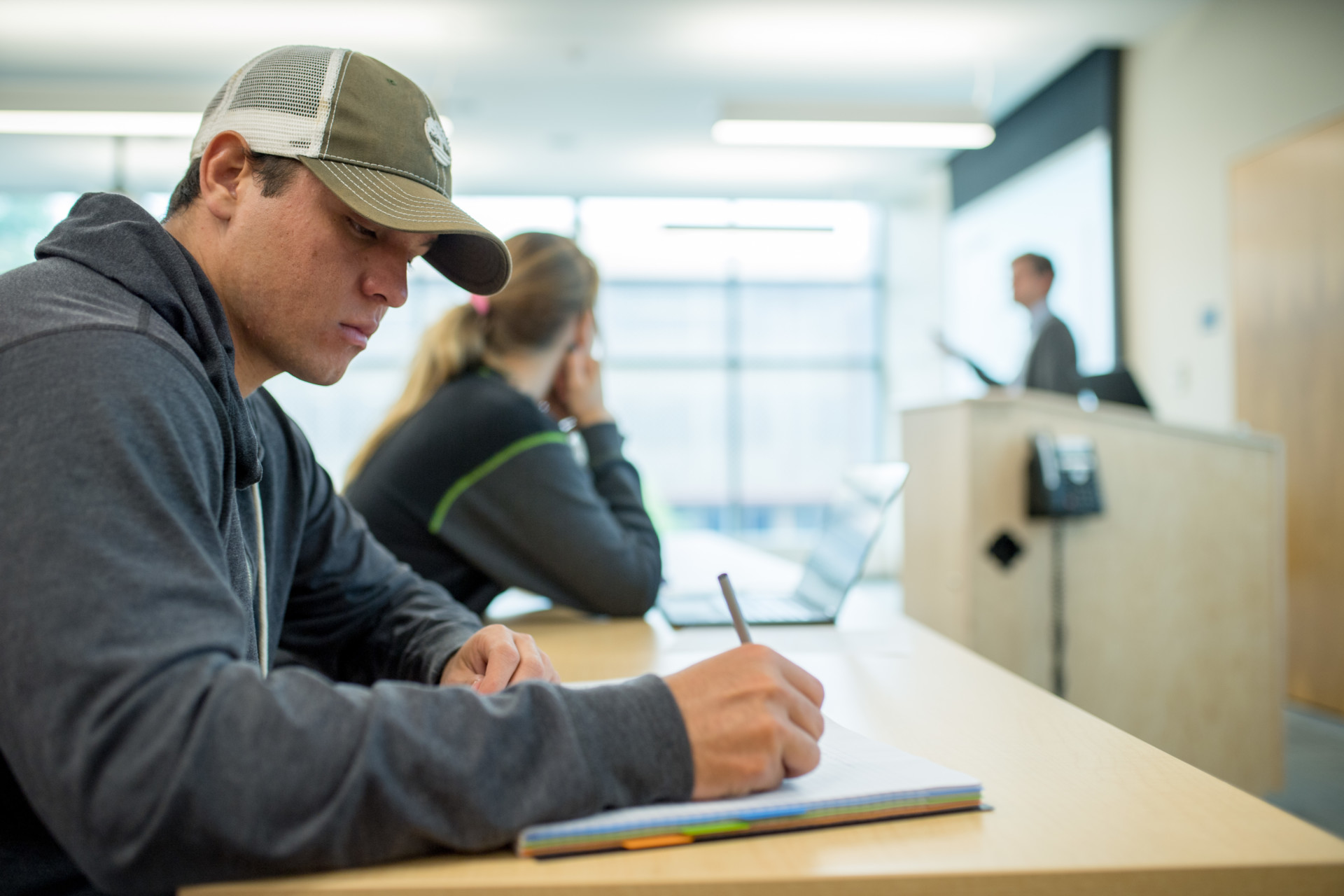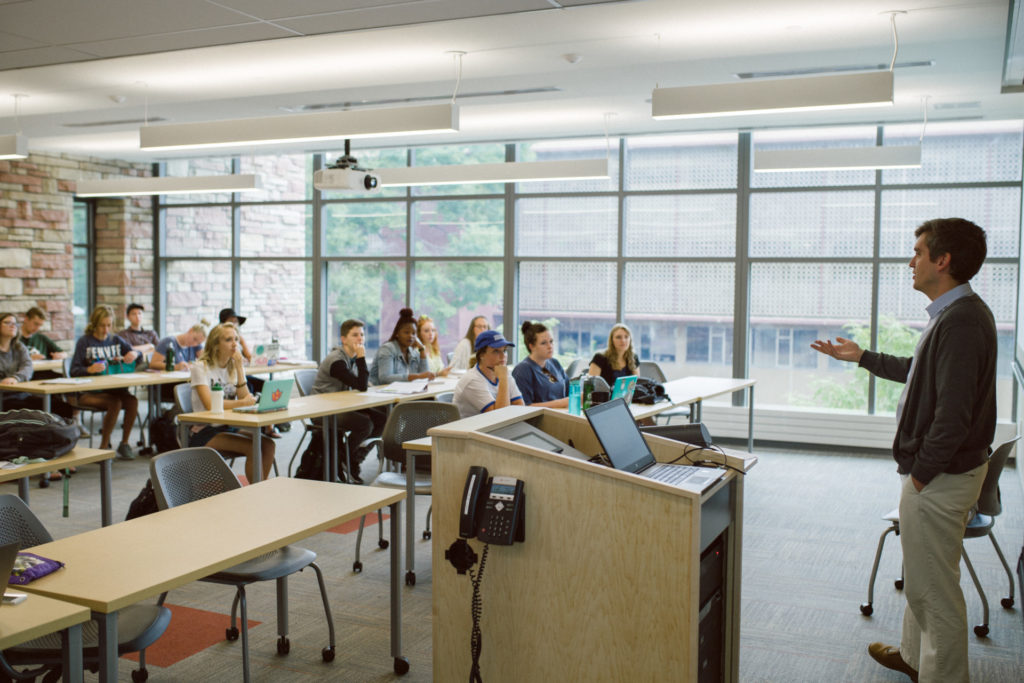
First-year students at CSU may think it’s best to adjust to college gradually.
But research shows that jumping in right away with a full course load is best for their academic success, and that the first four weeks are a crucial time for faculty and staff to make solid connections with students.
“Some students think they’ll ease into it and start by observing what their peers are doing,” explains Ryan Barone, assistant vice president for student success. “But if they do that, they’re significantly less likely to succeed.”
In fact, a CSU analysis shows that when first-year students are not meeting academic expectations at the four-week mark (as measured by attendance, test scores, keeping up with readings, etc.), they are much less likely to earn better than a C in the course, or even graduate.
Closing the gaps
As CSU works toward achieving President Tony Frank’s ambitious goal of reaching an 80 percent six-year graduation rate, the University is striving to close the gaps that exist for first-generation students, low-income students and students of color, who are currently 9 percent to 11 percent below the average CSU graduation rate overall, according to Barone.
Connecting with students during their first month on campus — and ensuring they are taking a recommended course load during their first year — has proven key to addressing those gaps. Two initiatives, First Four Weeks and Momentum Year, are among key strategies for 2018-19 and the second phase of the Student Success Initiative.
“The Momentum Year philosophy builds upon the First Four Weeks core message, which is to get started in full gear, fully engaging and keeping pace with significant milestones as you progress toward graduation,” says Kelly Long, vice provost for undergraduate affairs.
Get off to a strong start
CSU statistics show that students who complete 30 or more credit hours, including math and composition, within their first year have significantly higher retention rates and 76 percent higher odds of graduating.
Within the first year at CSU, students should:
- Successfully complete 30 credits
- Ensure that math and English composition are part of that coursework
- Complete 9 credits in an area of interest
- Develop a productive academic mindset
- Receive guidance on majors and advising with resources that include “My Majors,” “Ram Career Ready” and You@CSU
The recommendations
Each initiative contains five recommendations. For students in their first four weeks at CSU, faculty and staff are encouraged to build relationships and create a sense of belonging; set expectations; promote active, engaged learning; integrate student support into learning experiences; and help students know where they stand in their class.
For example, Barone said, faculty are advised to administer a low-stakes but graded assignment before the fourth week of classes, to let students know early on how they’re doing in the course.
Stephanie Clemons, a University Distinguished Teaching Scholar and professor in the Department of Design and Merchandising, says this simple strategy offers students the opportunity to develop a feel for the structure and difficulty of the course. It also allows faculty to share tips on “studying smarter and not longer” that may help students adjust their study practices to improve performance.
“Giving students an assessment in the first four weeks helps them understand how we’re going to be evaluating them,” she explains. “If we wait, it can be too late to recover.”
Spring workshop
Clemons worked with Paul Thayer, associate vice president emeritus, and Gwen Gorzelsky, director of The Institute for Learning and Teaching, to host a two-day First Four Weeks pilot workshop in May with 28 faculty from three colleges who teach large-enrollment freshman classes.
Presented in conjunction with the TILT Summer Conference, the event featured keynote speakers outlining data and strategies on the science of learning, active learning in large classes, and how learning works. Breakout sessions allowed faculty to share ideas on how to use the first five minutes of class, the first class, the first four weeks and the first semester to shape a message of caring about student success as well as academic rigor and expectations.

“The First Four Weeks initiative is much bigger than focusing on the first four weeks of the student’s experience at CSU,” Clemons says. “The vision relates to building students’ academic confidence that will carry them through their four years and beyond.”
“It’s such a major transition for students from the typical high school level,” she adds. “We want students to see themselves as CSU scholars who can absolutely achieve their educational goals. We want to help them graduate in four years. Every time I talk with our faculty, it is clear they genuinely care about and want to be a part of our students’ success. We know we play a pivotal role in setting our students’ trajectory toward academic excellence.”
“The First Four Weeks initiative has dynamic potential to enhance the student success experience on campus, and it offers great opportunity to involve faculty in student success goals and strategies,” Long explains. “As faculty engage with significant data that reflects the impact of the first four weeks on students’ overall retention and progress toward graduation, they also recognize their capacity to do simple things that can help make powerful differences in the lives and academic success of our students.”
Start strong
CSU statistics show that students who complete 30 or more credit hours, including math and composition, within their first year have significantly higher retention rates and 76 percent higher odds of graduating.
The university has used that finding, combined with a national initiative, to create five tenets for first-year students to build a Momentum Year that will launch them into a successful academic career. Within the first year at CSU, students should:
- Successfully complete 30 credits
- Ensure that math and English composition are part of that coursework
- Complete 9 credits in an area of interest
- Develop a productive academic mindset
- Receive guidance on majors and advising with resources that include “My Majors,” “Ram Career Ready” and You@CSU
Barone said a CSU-centric Momentum Year plan is being rolled out each of the next three years, to serve the class of 2022 and those who follow.
Interconnected initiatives
The First Four Weeks and Momentum Year efforts are not just for faculty and student support staff, according to Barone. The initiatives are being incorporated into Residence Life curricula and Parent and Family Programs, among other CSU units.
“An exciting aspect of the First Four Weeks initiative is that it reflects the CSU philosophy of recognizing the interconnection among classroom, residential, and student life experiences,” Long said. “Even as we roll out professional development opportunities to support faculty in their efforts, we are including more resources to support students in their first weeks on the campus as a whole.”
Check out the Ram Welcome schedule for our new students.
